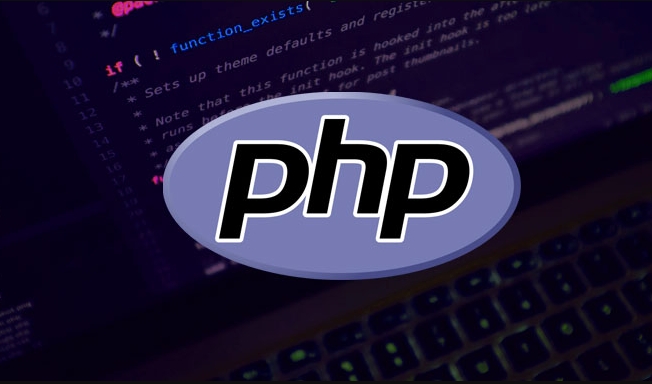The core of handling routing in modern PHP frameworks is to understand the unified entry mechanism and routing configuration methods. 1. The basic routing definition maps URLs to controller methods through routes.php or annotations, such as Laravel's Route::get(). It is recommended to centrally manage routes and use named routes to improve maintainability; 2. Routing parameters support dynamic path extraction and verification, such as using where() to limit parameter types to avoid injection risks; 3. Routing packets combine middleware to achieve permission control and modular management, reduce duplicate code and improve organizational logic capabilities; 4. Resource routing supports RESTful style, automatically creates standard CRUD routes, improves development efficiency and enhances collaboration consistency. Mastering these common practices allows you to flexibly respond to routing needs in different frameworks.

In modern PHP frameworks, the core is to understand its unified entry mechanism and routing configuration method. Most mainstream frameworks (such as Laravel, Symfony, Laminas, etc.) provide flexible routing systems that allow you to map URLs to the corresponding controller methods. Here are some practical practices to help you better understand and use the routing features in these frameworks.

1. Basic routing definition: from URL to controller
Modern PHP frameworks usually define routes through a routes.php or annotation. Taking Laravel as an example, you can write this:

Route::get('/about', [AboutController::class, 'index']);
This means that when the user accesses /about , index method in AboutController will be called. This structure clearly separates the URL and business logic.
suggestion:

- Centrally manage all routes for easy maintenance.
- Use named routes to facilitate link generation and redirection generation:
Route::get('/contact', [ContactController::class, 'show'])->name('contact.show');
- For simple GET/POST requests, just use the shortcut method provided by the framework.
2. Routing parameters and verification: not just passing values
Routing parameters are the basis of dynamic content, such as paths like /user/{id} . You can extract id from it and pass it to the controller.
Example:
Route::get('/user/{id}', [UserController::class, 'show']);Advanced skills:
- Add parameter validation rules to avoid invalid requests:
Route::get('/user/{id}', [UserController::class, 'show'])->where('id', '[0-9] '); - Use optional parameters (for frameworks such as Symfony):
user_profile: path: /user/{id}/{tab?} defaults: { tab: 'overview' }
Notes:
- Don't over-nest parameters, the URL should be concise and easy to read.
- It is best to limit the parameter types to avoid injection or error handling.
3. Routing grouping and middleware: Organizing more complex logic
As the project gets bigger, you need to group the routes, such as setting prefixes and middleware for the API and background respectively.
Laravel example:
Route::prefix('admin')->middleware('auth')->group(function () {
Route::get('/dashboard', [AdminController::class, 'dashboard']);
});benefit:
- Public prefix reduces duplicate code.
- Middleware unified control permissions, logs and other behaviors.
- Routes can be divided by module to improve maintainability.
Tips:
- When developing APIs, it is a good habit to use
api.phpto store interface routing separately. - Use middleware combinations reasonably, such as verifying login and role permissions at the same time.
4. Resource routing and RESTful style: write less and do more
Many frameworks support "resource routing" to help you automatically create standard CRUD routes.
Laravel example:
Route::resource('photos', PhotoController::class);
This statement will automatically generate the following route:
- GET
/photos→ List - GET
/photos/{id}→ View - POST
/photos→ Create - PUT
/photos/{id}→ Update - DELETE
/photos/{id}→ Delete
Advantages:
- Reduce repetitive labor.
- Comply with RESTful design specifications.
- It's easier to collaborate with other developers.
Basically that's it. By mastering these common practices, you can flexibly respond to various routing needs in different PHP frameworks. Although the grammar of each framework is slightly different, the ideas are basically the same, and the key is to understand the design pattern behind it.
The above is the detailed content of how to handle routing in a modern php framework. For more information, please follow other related articles on the PHP Chinese website!

Hot AI Tools

Undress AI Tool
Undress images for free

Undresser.AI Undress
AI-powered app for creating realistic nude photos

AI Clothes Remover
Online AI tool for removing clothes from photos.

Clothoff.io
AI clothes remover

Video Face Swap
Swap faces in any video effortlessly with our completely free AI face swap tool!

Hot Article

Hot Tools

Notepad++7.3.1
Easy-to-use and free code editor

SublimeText3 Chinese version
Chinese version, very easy to use

Zend Studio 13.0.1
Powerful PHP integrated development environment

Dreamweaver CS6
Visual web development tools

SublimeText3 Mac version
God-level code editing software (SublimeText3)

Hot Topics
 How do I implement authentication and authorization in PHP?
Jun 20, 2025 am 01:03 AM
How do I implement authentication and authorization in PHP?
Jun 20, 2025 am 01:03 AM
TosecurelyhandleauthenticationandauthorizationinPHP,followthesesteps:1.Alwayshashpasswordswithpassword_hash()andverifyusingpassword_verify(),usepreparedstatementstopreventSQLinjection,andstoreuserdatain$_SESSIONafterlogin.2.Implementrole-basedaccessc
 How can you handle file uploads securely in PHP?
Jun 19, 2025 am 01:05 AM
How can you handle file uploads securely in PHP?
Jun 19, 2025 am 01:05 AM
To safely handle file uploads in PHP, the core is to verify file types, rename files, and restrict permissions. 1. Use finfo_file() to check the real MIME type, and only specific types such as image/jpeg are allowed; 2. Use uniqid() to generate random file names and store them in non-Web root directory; 3. Limit file size through php.ini and HTML forms, and set directory permissions to 0755; 4. Use ClamAV to scan malware to enhance security. These steps effectively prevent security vulnerabilities and ensure that the file upload process is safe and reliable.
 What are the differences between == (loose comparison) and === (strict comparison) in PHP?
Jun 19, 2025 am 01:07 AM
What are the differences between == (loose comparison) and === (strict comparison) in PHP?
Jun 19, 2025 am 01:07 AM
In PHP, the main difference between == and == is the strictness of type checking. ==Type conversion will be performed before comparison, for example, 5=="5" returns true, and ===Request that the value and type are the same before true will be returned, for example, 5==="5" returns false. In usage scenarios, === is more secure and should be used first, and == is only used when type conversion is required.
 How do I perform arithmetic operations in PHP ( , -, *, /, %)?
Jun 19, 2025 pm 05:13 PM
How do I perform arithmetic operations in PHP ( , -, *, /, %)?
Jun 19, 2025 pm 05:13 PM
The methods of using basic mathematical operations in PHP are as follows: 1. Addition signs support integers and floating-point numbers, and can also be used for variables. String numbers will be automatically converted but not recommended to dependencies; 2. Subtraction signs use - signs, variables are the same, and type conversion is also applicable; 3. Multiplication signs use * signs, which are suitable for numbers and similar strings; 4. Division uses / signs, which need to avoid dividing by zero, and note that the result may be floating-point numbers; 5. Taking the modulus signs can be used to judge odd and even numbers, and when processing negative numbers, the remainder signs are consistent with the dividend. The key to using these operators correctly is to ensure that the data types are clear and the boundary situation is handled well.
 How can you interact with NoSQL databases (e.g., MongoDB, Redis) from PHP?
Jun 19, 2025 am 01:07 AM
How can you interact with NoSQL databases (e.g., MongoDB, Redis) from PHP?
Jun 19, 2025 am 01:07 AM
Yes, PHP can interact with NoSQL databases like MongoDB and Redis through specific extensions or libraries. First, use the MongoDBPHP driver (installed through PECL or Composer) to create client instances and operate databases and collections, supporting insertion, query, aggregation and other operations; second, use the Predis library or phpredis extension to connect to Redis, perform key-value settings and acquisitions, and recommend phpredis for high-performance scenarios, while Predis is convenient for rapid deployment; both are suitable for production environments and are well-documented.
 How do I stay up-to-date with the latest PHP developments and best practices?
Jun 23, 2025 am 12:56 AM
How do I stay up-to-date with the latest PHP developments and best practices?
Jun 23, 2025 am 12:56 AM
TostaycurrentwithPHPdevelopmentsandbestpractices,followkeynewssourceslikePHP.netandPHPWeekly,engagewithcommunitiesonforumsandconferences,keeptoolingupdatedandgraduallyadoptnewfeatures,andreadorcontributetoopensourceprojects.First,followreliablesource
 What is PHP, and why is it used for web development?
Jun 23, 2025 am 12:55 AM
What is PHP, and why is it used for web development?
Jun 23, 2025 am 12:55 AM
PHPbecamepopularforwebdevelopmentduetoitseaseoflearning,seamlessintegrationwithHTML,widespreadhostingsupport,andalargeecosystemincludingframeworkslikeLaravelandCMSplatformslikeWordPress.Itexcelsinhandlingformsubmissions,managingusersessions,interacti
 How to set PHP time zone?
Jun 25, 2025 am 01:00 AM
How to set PHP time zone?
Jun 25, 2025 am 01:00 AM
TosettherighttimezoneinPHP,usedate_default_timezone_set()functionatthestartofyourscriptwithavalididentifiersuchas'America/New_York'.1.Usedate_default_timezone_set()beforeanydate/timefunctions.2.Alternatively,configurethephp.inifilebysettingdate.timez






